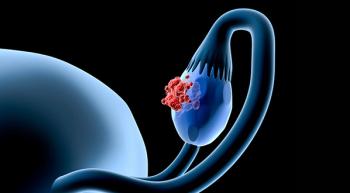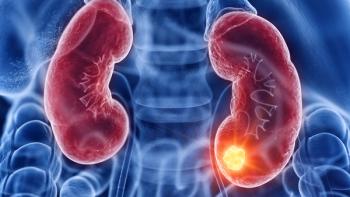
Upfront 4-Drug Regimen Is Tolerable in Lung Cancer Treatment
The 4-drug combination of atezolizumab (Tecentriq), bevacizumab (Avastin), carboplatin, and paclitaxel (ABCP) improved survival while maintaining good health-related quality of life (QOL) in patients with nonsquamous non–small cell lung cancer .
The 4-drug combination of atezolizumab (Tecentriq), bevacizumab (Avastin), carboplatin, and paclitaxel (ABCP) improved survival while maintaining good health-related quality of life (QOL) in patients with nonsquamous non—small cell lung cancer (NSCLC), according to patient-reported outcomes (PROs) from the phase 3 IMpower150 trial published in the Journal of Clinical Oncology.1
In the randomized, open-label trial, patients with chemotherapy-naïve metastatic NSCLC were randomly assigned 1:1:1 to receive ABCP; atezolizumab, carboplatin, and paclitaxel (ACP); or bevacizumab, carboplatin, and paclitaxel (BCP). Overall, 393 patients in the ABCP arm were determined to be evaluable for the safety analysis, along with 400 and 394 patients in the ACP and BCP arms, respectively.
Results showed that the majority of patients experienced grade 3/4 treatment-related adverse events (TRAEs) during the induction phase of treatment versus the maintenance phase (ABCP, 48.6% vs 21.2%; ACP, 40.5% vs 8.2%; BCP, 44.7% vs 11.1%). During the induction phase, the incidence of serious AEs (SAEs) was 28.5%, 28.3%, and 26.4% in the ABCP, ACP, and BCP arms, respectively. During the maintenance phase, SAE incidences were 26.3%, 20.0%, and 13.0%, respectively. Completion rates of the PRO questionnaires were >88% at baseline and remained ≥70% throughout study visits. Across all treatment arms, patients did not report clinically meaningful worsening of global health status or physical functioning scores through cycle 13.
“Overall, safety and PRO data from IMpower150 support the positive benefit-risk profile demonstrated by the clinical data with atezolizumab plus bevacizumab and chemotherapy in first- line nonsquamous NSCLC,” lead investigator, Martin Reck, MD, PhD, of the LungenClinic, and coinvestigators wrote.
Previous results from IMpower150 showed that among patients with nonsquamous disease that did not harbor an EGFR or ALK mutation, the estimated overall survival (OS) was 19.2 months with the 4-drug regimen versus 14.7 months with BCP (HR, 0.78; 95% CI, 0.64-0.96; P = .016).2 The estimated median progression-free survival (PFS) was 8.5 months with the 4-drug regimen versus 7.0 months with the control (HR, 0.71; 95% CI, 0.59-0.85; P = .0002). Additionally, the overall response rates were 55% in the 4-drug arm versus 42% in the control arm. No significant differences had been observed between the 3-drug arm and the control arm. These results led to the December 2018 FDA approval of the 4-drug regimen in this patient population.
The objective of the recently released analysis was to assess the safety and tolerability of the 4-drug regimen and to capture feedback from patients regarding the severity of commonly experienced AEs associated with the 3 treatment regimens so that their impact on health-related QOL and physical functioning could be appropriately categorized.
To this end, the incidence, nature, and severity of all-cause AEs, TRAEs, and AEs of special interest were assessed. A secondary end point of the analysis included PROs, which were evaluated using the European Organization for Research and Treatment of Cancer Quality of Life Questionnaire (EORTC QLQ)-Core 30 and EORTC QLQ-Lung Cancer 13. The EORTC QLQ-C30 consists of 30 questions that assess 5 aspects of patient functioning (physical, emotional, role, cognitive, and social), 3 symptom scales (fatigue, nausea and vomiting, and pain), global health/QOL, and 6 single items (dyspnea, insomnia, appetite loss, constipation, diarrhea, and financial difficulties).
Questionnaires were completed at each visit during treatment as well as 3 and 6 months following disease progression or until loss of clinical benefit in atezolizumab-treated patients who had continued treatment with the agent following radiographic disease progression.
The data cutoff date for this analysis was January 22, 2018 and the minimum duration of follow-up was 13.5 months (median, 19.6, 19.6, and 19.7 months for ABCP, ACP, and BCP, respectively). The median age of those enrolled was 63 years across all arms and 59.8% of patients were male.
Results showed that the incidence of grade 5 all-cause AEs was comparable across treatment phases in all arms; however, the incidence of grade 5 TRAEs was higher during the induction versus the maintenance phase with ABCP. The incidence of grade 3/4 and grade 5 atezolizumab-related AEs were reported to be comparable across the ABCP and ACP arms.
The majority of the AEs most commonly reported (≥20% incidence) across treatment phases were grade 1/2 in severity. The most common events reported in the ABCP arm during the induction phase included alopecia (46.8%), nausea (33.3%), and fatigue (27.7%), while alopecia (44.0%), anemia (33.5%), nausea (28.5%), and peripheral neuropathy (23.8%) were the most common events reported during this phase in the ACP arm. In the maintenance phase, hypertension was the most common AE reported in both the ABCP and BCP arms (18.9% vs 12.2%, respectively), while dyspnea (12.1%) was the most common AE reported during this phase in the ACP arm.
The overall incidence of AEs that resulted in the discontinuation of any study treatment was 33.8% with ABCP, 13.3% with ACP, and 24.9% with BCP.
During induction, the incidence of AEs that led to discontinuation of any study treatment was 22.4% in the ABCP arm, 17.8% in the BCP arm, and 9.5% in the ACP arm. The most common AEs that led to any treatment discontinuation during this phase (≥1% of patients) included peripheral sensory neuropathy (ABCP, 2.0%; ACP, 1.0%; BCP, 1.0%), peripheral neuropathy (ABCP, 1.8%; ACP, 1.0%; BCP, 0.8%), pulmonary embolism (ABCP, 1.3%; ACP, 0%; BCP, 1.3%), thrombocytopenia (ABCP, 1.0%; ACP, 0%; BCP, 1.0%), and febrile neutropenia (ABCP, 0.5%; ACP, 0%; ACP, 1.0%).
During the maintenance phase, the incidence of AEs that resulted in discontinuation of any treatment proved to be higher with ABCP compared with the other 2 arms. The most commonly reported events that resulted in discontinuation during this phase (≥1% of patients) included proteinuria (ABCP, 2.9%; ACP, 0%; BCP, 2.6%), hypertension (ABCP, 1.9%; ACP, 0%; BCP, 0%), increased alanine aminotransferase (ABCP, 1.0%; ACP, 0%; BCP, 0%), and diarrhea (ABCP, 1.0%; ACP, 0%; BCP, 0%).
“Despite the higher grade 3/4 TRAE rates in the ABCP arm than in the ACP and BCP arms, these findings support the safety and tolerability of ABCP and provide insight on the ABCP regimen to the medical community beyond its regulatory approval,” the investigators wrote.
Of the 400 patients in the ACP arm who received intended treatment, 92.8% (n = 371) completed the EORTC QLQ-C30 and 92.5% (n = 370) completed the EORTC QLQ-LC13 at baseline. The respective rates of completion were 90.6% (n = 356/393) and 88.8% (n = 349/393) in the ABCP arm, and 91.4% (n = 360/394) and 89.8% (n = 354/394) in the BCP arm.
Patient-reported disease burden was reported to be similar across the treatment arms at baseline, with patients reporting moderate to high functioning and minimal symptom burden. On average, patients did not report clinically meaningful worsening of global health status or physical functioning scores at any time through cycle 13 in any arm.
Additionally, average global health status and physical functioning scores continued to be comparable during the induction treatment phase with a trend toward improvement during the maintenance phase. Across all time points evaluated, mean global health status and physical functioning scores proved to be mostly similar in the ABCP and BCP arms.
“Across arms, patients reported no clinically meaningful worsening in mean health-related QOL, physical functioning, or symptom scores at any point through cycle 13, except for patient-rated severity of peripheral neuropathy,” the investigators wrote. “The PRO data suggest a minimal difference in treatment burden among arms and highlight an overall sense of the patient’s well-being, which may not necessarily be reflected in the reporting of clinical safety.”
These data provide additional patient-centric evidence to inform the tolerability of atezolizumab administered in combination with bevacizumab and chemotherapy as frontline treatment of patients with nonsquamous NSCLC, the investigators concluded.
References
1. Reck M, Wehler T, Orlandi F, et al. Safety and patient-reported outcomes of atezolizumab plus chemotherapy with or without bevacizumab versus bevacizumab plus chemotherapy in non—small-cell lung cancer. J Clin Oncol. Published online March 27, 2020. doi:10.1200/JCO.19.03158
2. FDA approves atezolizumab with chemotherapy and bevacizumab for first-line treatment of metastatic non-squamous NSCLC. News release. US Food and Drug Administration. December 6, 2018. Accessed June 10, 2020. bit.ly/3cSdFT4.
This article was originally published on OncLive as, "
Newsletter
Knowledge is power. Don’t miss the most recent breakthroughs in cancer care.
























































































